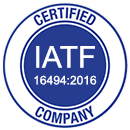Vacuum forming is a simplified version of thermoforming, whereby a sheet of plastic is heated to a forming temperature, stretched onto a convex, or into a concave, single-surface mold, and forced against the mold by a vacuum (suction of air). The vacuum forming process can be used to make most product packaging and speaker casings. It is also used to fabricate car dashboards. This is also known as vacuum molding.
Vacuum forming is usually, although not always, restricted to forming plastic parts that are rather shallow in depth. Thin sheets are formed into rigid cavities for unit doses of pharmaceuticals and for loose objects that are carded or presented as point of purchase items. Thick sheet is formed into permanent objects such as turnpike signs and protective covers. Normally, draft angles must be present in the design on the mold (a recommended minimum of 3°). Otherwise, release of the formed plastic and the mold is difficult.
Relatively deep parts can be formed if the formable sheet is mechanically or pneumatically stretched prior to bringing it into contact with the mold surface and applying vacuum.
Suitable materials for use in vacuum forming are conventionally thermoplastics. The most common and easiest to use thermoplastic is high impact polystyrene sheeting (HIPS). This is molded around a wood, structural foam or cast or machined aluminium mold, and can form to almost any shape. Vacuum forming is also appropriate for transparent materials such as acrylic, which are widely used in applications for aerospace such as passenger cabin window canopies for military fixed wing aircraft and compartments for rotary wing aircraft. Vacuum forming is often used in low-level technology classes for an easy way to mold.
Typical applications
Original equipment manufacturers (OEMs) utilize heavy gauge vacuum formed components for production quantities in the range of 250–3000 units per year. Vacuum-formed components can be used in place of complex fabricated sheet metal, fiberglass, or plastic injection molding. Typical industry examples include kiosks and automated teller machines, enclosures for medical imaging and diagnostic equipment such as magnetic resonance imaging (MRI) machines, engine covers in a truck cab, and railcar interior trim and seat components.
Common problems
There are some problems encountered in the vacuum forming process. Absorbed moisture can expand, forming bubbles within the plastic’s inner layers. This significantly weakens the plastic. However, this can be solved by drying the plastic for an extended period at high but sub-melting temperature. Webs can form around the mold, which is due to overheating the plastic and so must be carefully monitored. Webbing can also occur when a mold is too large or parts of the mold are too close together. Finally, objects that are formed often stick to the mold, which is remedied by using a draft angle of three degrees or more in the mold.
Vacuum forming tool
Wood patterns are generally the first stage in vacuum forming. They are relatively inexpensive and allow the customer to make changes to their design easily. The number of samples that one is able to get from a wood pattern depends on the size of the part and the thickness of the material. Typically, wood patterns are used to gauge general functionality of both the part and the thickness of the material. Once the specifications of the part have been met, the wood pattern is then used to create a ceramic composite mold, or cast aluminum mold for regular production.
Cast aluminium molds are cast at a foundry and typically have temperature control lines running through them. This helps to set the heat of the plastic being formed as well as speed up the fabrication process. Aluminium molds can be male or female in nature, and can also be used in pressure forming applications. The main drawback with this type of mold is cost.
Machined aluminium molds are like cast aluminium, but are cut out of a solid block of aluminium using a CNC machine and a CAD program. Typically, machined aluminium is used for shallow draw parts out of thin gauge material. Applications may include packaging and trays. Cost is a significant factor with this type of tooling.
Composite molds are a lower cost alternative to cast or machined aluminium molds. Composite molds are typically made from filled resins that start as a liquid and harden with time. Depending on the application, composite molds can last a very long time and produce high quality parts. Within the category of composite molds, the subset of ceramic molds has consistently proven to be the most durable. While not temperature controlled, these molds can run nearly as fast as cast or machined aluminium, yet at a substantially lower price point.








